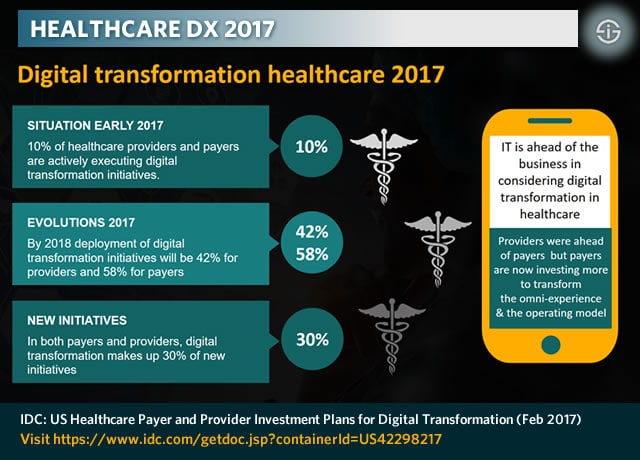Both healthcare providers and healthcare payers are poised to drastically increase the deployment of digital transformation projects and initiatives in the US.
According to an IDC survey, released in February 2017, only 10 percent of hospitals, other healthcare providers and payers are currently effectively executing healthcare digital transformation initiatives.
Yet, by next year, 42 percent of providers and 58 percent of payers will be in digital transformation deployments. In other words: the US healthcare sector will see some significant changes becoming reality.
Healthcare IT investments by healthcare payers and providers
In previous research, IDC provided forecasts regarding the types of IT investments we can expect from providers and payers in the healthcare industry across the globe over a longer period, as mentioned on our digital transformation in healthcare page.
Here as well, there is quite some transformation going on, with a clear role for the IoT.

On the healthcare providers side, the research showed that hospitals are, among others, looking to deploy robots for the delivery of medications, food and other supplies, and predicted that over 40 percent of healthcare organizations will use IoT-enabled biosensors by 2019. Another sign that the deployment of IoT in healthcare is expanding fast.
Among the initiatives at the healthcare payers side are the implementation of Robotic Process Automation (RPA) tools and process reengineering, which should lead to a global saving of $1 Billion by end 2018. Previously we also mentioned how healthcare payers are poised to increasingly leverage healthcare data and data from wearables and other IoT devices to transform their models.
Healthcare payers catching up with healthcare providers
However, for now it seems that the types of projects and goals are more about foundational digital transformation investments, certainly on the side of US healthcare payers.
The 2017 survey for example shows how healthcare payers are catching up with healthcare providers who were ahead in digital technology investments thus far.
Looking at the main goals of digital technology investments which will be done by payers in 2017, we mainly see the transformation of the omni-experience and the operating model with especially investments in cloud, Big Data, analytics and security.
The majority of the digital transformation projects which is about to be rolled out this year currently either is in a pilot or research phase.
Healthcare digital transformation initiatives account for 30% of new healthcare initiatives
The new IDC report, based on a survey which is entitled “Payer and Provider Investment Plans for Digital Transformation”, looked at investment plans in five different healthcare areas.
These are the Internet of Things in healthcare, value-based healthcare, connected health, digital transformation and, finally, clinician collaboration and communication/mobile. The digital transformation initiatives part accounts for 30 percent of all new initiatives, IDC states.
Noteworthy but perhaps not that surprising (at least in this stage): in considering healthcare digital transformation, the IT department is ahead of the business side.
Finally, approximately a third of healthcare payers is more prone to work with consulting firms in planning their digital transformation strategy than healthcare providers do.

